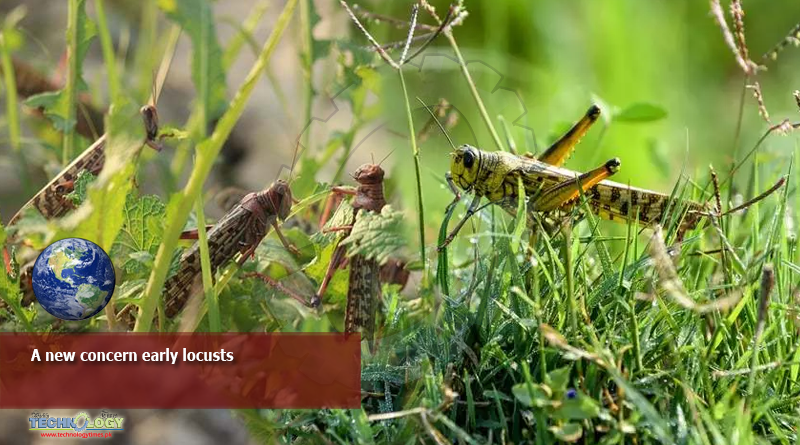Locusts normally arrive during July-October, but have already been spotted in Rajasthan. At a time India is battling Covid, they present a new worry with their potential for exponential growth and crop destruction.

On April 11-12, scientists at the Locust Warning Organisation (LWO) observed groups of grasshoppers at Sri Ganganagar and Jaisalmer districts of Rajasthan. But far from ordinary hoppers, these were desert locusts — the same destructive migratory pests currently devouring acres of maize, sorghum and wheat crops in East Africa.
While locusts are seen in India as well, that is normally only during July-October and mostly as solitary insects or in small isolated groups. Their being spotted along the India-Pakistan border before mid-April this time — and coming after the damage they caused to the growing rabi crops along western Rajasthan and parts of northern Gujarat during December-January — has raised the alarm bells, and comes at a time when the country is battling the more high-profile novel coronavirus pandemic.
What exactly are locusts?
The desert locust (Schistocerca gregaria) is a short-horned grasshopper that is innocuous while it is in a “solitary phase” and moving about independently. These winged insects differ from normal hoppers, and become dangerous only when their populations build up rapidly and the close physical contact in crowded conditions triggers behavioural changes. They, then, enter the “gregarious phase”, by grouping into bands and forming swarms that can travel great distances (up to 150 km daily), while eating up every bit of vegetation on the way. If not controlled at the right time, these insect swarms can threaten the food security of countries. Kenya is already reporting its worst locust outbreak in 70 years, while Ethiopia and Somalia haven’t seen one this bad in quarter of a century.
How seriously should the first sightings of the locusts by the LWO be viewed?
There’s nothing much to worry right now, as the rabi crop has already been harvested and farmers are yet to commence plantings for the new kharif season. The LWO (part of the Union Agriculture Ministry’s directorate of plant protection, quarantine & storage and with its field headquarters at Jodhpur in Rajasthan) has since the second fortnight of April detected “gregarious” hopper groups, including at Fazilka in Punjab adjoining the Pakistan border. But these have been low-density nymphs in “2nd to 4th instar” stages or immature winged adults. No breeding or swarm movement has also been seen so far. Where they are, where they are headed: The map, from the UN Food and Agriculture Organization, shows areas of locust presence and projections for their movement. Click to enlarge
The timing, though, is cause for concern. The normal breeding season for locusts in India is July-October. But this time, they have been sighted by mid-April. Last year, too, they were seen towards end-May as isolated grasshoppers. They could, nevertheless, breed to high enough populations for forming swarming and wreaking havoc during the rabi season in Rajasthan (especially Ganganagar, Hanumangarh, Bikaner, Jaisalmer, Jodhpur, Nagaur, Jalore and Sirohi) and Gujarat (Banaskantha). The longer time to breed is more conducive for build-up of gregarious insect swarms, as opposed to solitary, innocuous hoppers.
Also in Explained: Why China is sending ducks to tackle locust attacks in Pakistan
What kind of damage can they cause?
What is the genesis of the present locust upsurge, particularly in East Africa?
It lies in the Mekunu and Luban cyclonic storms of May and October 2018 that struck Oman and Yemen, respectively. These turned large desert areas in remote parts of the southern Arabian Peninsula into lakes, which allowed the insects to breed undetected across multiple generations. The swarms attacking crops in East Africa reached peak populations from November onwards, while building up since the start of this year in southern Iran and Pakistan (Balochistan and parts of the Indus Valley and Punjab). Widespread rains in East Africa in late March and April have enabled further breeding.
According to Keith Cressman, senior locust forecaster at the Food and Agricultural Organization of the UN, a part of the new generation of swarms forming there in late-June/July may migrate from the Horn of Africa across the Indian Ocean to the desert areas along both sides of the India-Pakistan border. Prior to that, the locusts from spring breeding areas of southwest Pakistan and southern Iran would arrive in Rajasthan and Gujarat during May-June. They would, then, breed with the onset of the southwest monsoon rains and continue doing so through the kharif cropping season.
What can and should be done?
If the monsoon is good, and in the absence of control operations, the magnitude of attack could be worse than in the 2019-20 rabi season. Gurjar points out that last year’s locust incursions were the first and most significant since 1993. Local authorities in Rajasthan and Gujarat had to treat over 4.30 lakh hectares of infested areas with sprayers mounted on tractors and other vehicles. Thankfully, even old generation organophosphate insecticides such as Malathion (96% ultra-low volume aerial application) are effective against locusts. About one litre of the chemical is necessary to treat a hectare of their breeding areas, including trees where they halt for the night. Gurjar says that there is ample stock of pesticides to control any swarms. Control operations also require procurement of equipment, training of field teams, prepositioning of supplies in key breeding areas and updating contingency plans. These operations are technically not restricted under the current lockdown regime. But there is not much time to waste either.
Originally Publish at: https://indianexpress.com/
